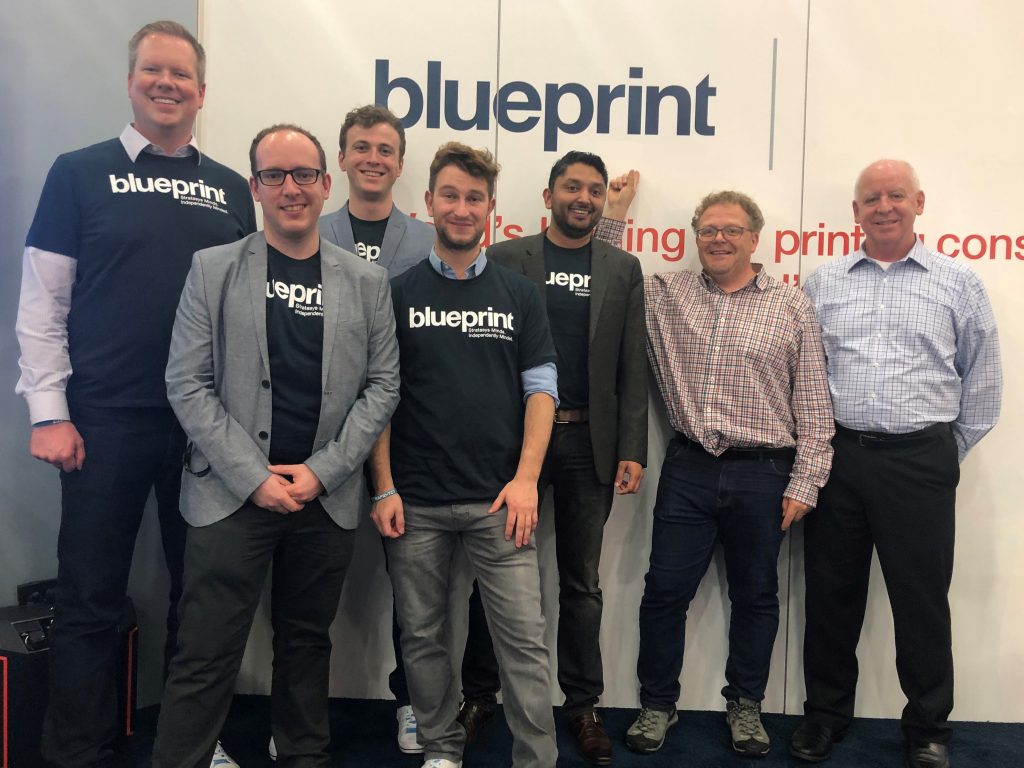Just recently Stratasys launched Blueprint. Stratasys has had a consulting arm for a number of years now. The firm wanted to present and establish the Blueprint as independent-minded however. Application development and getting customers from standstill to up to speed in 3D printing is a hugely challenging task. It is rare that people can bridge both the technical side of things and business enough to translate needs into appropriate strategies. Industrializing processes and new materials is also very challenging and each new market or material has its unique challenges. Blueprint will have to also maintain its independence and independent thought while still being a part of one of the largest 3D printer OEMs in the field. Will the team succeed? This responsibility is on the shoulders of the very bright Kunal Mehta, whom we interviewed.

What is Blueprint?
We’re the world’s leading 3D printing consultants. We have 15 years of experience helping clients across virtually every industry. We’re engineers, innovators, analysts, and strategists. We are laser-focused on helping our clients make sense of 3D printing.
So, I pay you and then you tell me to get a Stratasys Printer?
No. We’re technology agnostic. We help our clients find where 3D printing will deliver the most value in their business and make recommendations based on that. Sometimes, the answer isn’t a printer; it could be a relationship with a service bureau, a change in operating model, or upskilling a department. In fact, in the last few projects, our recommendations led to new business models, including suggesting competitors printers.
What kind of engagements have you done?
We’ve done engagements ranging from high-level strategy and innovation, to deeply technical design optimization, at startups and Fortune 500 companies alike. Generally, our engagements fit into one of our seven offerings:
- Strategic Impact, helping senior leaders understand how 3D printing will impact their business
- Product Innovation, helping professionals understand how 3D printing can drive top-line growth through innovation
- Additive Deployment, creating the model for deploying additive in organizations
- Operational Improvement, diving deep into processes to help clients learn how additive can make operations leaner and smarter
- Application Validation, validating the business case for specific additive applications before committing to a manufacturing process
- Design Optimization, diving deep with engineers to realize their design intent using 3D printing
- Think Additively, teaching clients how to understand design for additive manufacturing with a business mindset
For what kinds of customers would you like to work with?
We bring the most value with engaged clients that are forward thinking and looking to really innovate in their businesses. Those are the types of clients that are willing to take a leap of faith, trust us, and trust what the technology can deliver. These types of clients can be new to additive or can be established power users, and they can be big or small.
What kind of experience do you bring to the table?
The origin of our group was Econolyst, a world-leading additive consultancy, started over 15 years ago, which Stratasys acquired in 2015. That said, the Blueprint team has worked with hundreds of clients and has developed a deep bench of methodologies, tools and thought leadership; but what’s really special about us is that we have deep experience in additive combined with a diverse array of talent. On our team, we have customer experience experts, people who have experience in supply chain, industrial engineers, and we even have a person with a degree in model making.
So, what advice would you give me if I’m a firm looking to use 3D printing?
Start by understanding why you want to use 3D printing and what 3D printing is being used for in your industry and related industries. Spend time thinking about your business case for additive before you start looking at machine specs. Figuring out how 3D printing makes sense for your business is much harder than purchasing a machine. Then come to us to help you understand your business case and generate concepts, ideas and applications.
And if I want to use 3D printing for production?
That’s a risky proposition unless you’re already using it for applications like prototyping, jigs and fixtures, and tooling. You need to get your hands dirty and use the technology for some prototypes or tools first. You need to botch a few builds and learn from that. You’re not going to paint the Mona Lisa the first time you pick up a paintbrush.
On what technologies do you advise customers?
We help clients find the business case for 3D printing. Our methodology informs our technology recommendations. If 3D printing has value for a company, we analyze what is available today and what is on the horizon; we don’t limit the scope by technology, material, manufacturer, or supplier. Case in point, we developed the 6 Business Driver Framework for 3D printing which is described in our recently released book – “The Little Blue Book of 3D Printing,” that can be downloaded directly from our website.

How does a typical engagement work?
We start with a conversation. We start by understanding what our clients are looking to solve. We then create a bespoke approach and leverage our arsenal of tools to deliver.
We live by our values. We are Trusted. We are Enablers. We are Human. That means we’re motivated by our clients’ success, we take a genuine interest in helping and we never forget that we’re working with people. At the end of the engagement, we’ve all learned something, we’ve created demonstrable value, and we’ve had some fun.
What stumbling blocks do companies entering 3D printing often encounter?
If you ask engineering, you’ll hear something about materials. If you ask procurement, it’s all about cost. The truth is that the biggest stumbling blocks are very human issues. Based on talking to our clients and our experience, we have the data on this. Lack of talent, management focus, project ownership, change management… These are the same things that affect every initiative.
Also, there’s a tendency to believe the hype around any technology, but a big part of the story that gets left out is how anything worth doing takes time, effort, and focus. If it didn’t, you’d already be doing it. Consequently, companies often bite off more than they can chew, and they’re the ones who end up getting bitten.

Why is it difficult to design for additive?
Remember, additive manufacturing is a very new tool. Additive has only been technically viable for production for maybe a decade. Like any new technology, it takes time to learn. It took 40 years for computers to become commonly used tools in business… and in many cases, the jury’s still out on whether we’re more effective with computers on our desks. It will take time for most engineering organizations to build up this experience.
More to the point, additive manufacturing grants you a unique set of design freedoms, but it also imposes some constraints. Being effective with additive will require designers and engineers to understand the freedoms and constraints. We’ve created a training offering around this. It’s called “Think Additively.”
From an organizational perspective, why do 3D printing implementations go wrong?
Silos. The most impactful and interesting opportunities in additive manufacturing are at the intersection of engineering, supply chain, and manufacturing, but these groups often don’t work together. It requires a fundamentally different way of collaboration.
Also, people have unrealistic expectations. There is no one silver bullet technology or machine and you’re not going to see an immediate return on investment the first time you print something. Anyone who tells you differently is probably selling something.
What materials are you looking forward to seeing?
More than materials, we’re looking forward to seeing processes improve. Being able to build faster, cheaper, and more consistently, is what is going to be the enabler. Also, we’re looking forward to seeing more process certifications. Once heavily regulated industries like aerospace and rail become comfortable with the consistency of the available printing processes, we’re going to see some interesting stuff.

Where will Blueprint be in five years?
Probably mostly on planes, en route to our clients. But, in general, we want to be a household name in the manufacturing industry. And we want to be able to say that we had a hand in changing a few industries for the better.
Subscribe to Our Email Newsletter
Stay up-to-date on all the latest news from the 3D printing industry and receive information and offers from third party vendors.
You May Also Like
3D Printing Financials: Fathom Struggles in Financial Quicksand During Critical Transition
Facing a year of key transitions and financial pressures, Fathom (Nasdaq: FTHM) has filed its annual report for 2023 with the U.S. Securities and Exchange Commission (SEC). The document outlines...
Latest Earnings Overview for Australian 3D Printing Firms Titomic and AML3D
Australian 3D printing manufacturing firms Titomic (ASX: TTT) and AML3D (ASX: AL3) reported their financial results for the period from July to December 2023, marking the first half of their...
3D Printing Webinar and Event Roundup: April 7, 2024
Webinars and events in the 3D printing industry are picking back up this week! Sea-Air-Space is coming to Maryland, and SAE International is sponsoring a 3D Systems webinar about 3D...
3D Printing Financials: Unpacking Farsoon and BLT’s 2023 Performance
In the Chinese 3D printing industry, two companies, Farsoon (SHA: 688433) and Bright Laser Technologies, or BLT (SHA: 688333), have recently unveiled their full-year earnings for 2023. Farsoon reported increases...































